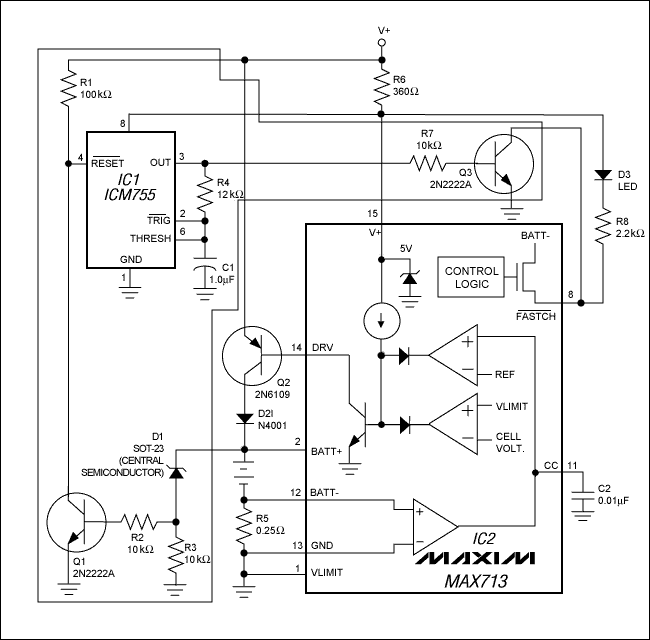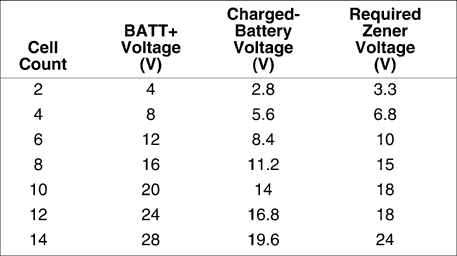

Battery Charger Indicates Tric
电源新闻
20人已加入
描述
A single LED indicates whether the battery charger of Figure 1 is delivering a fast charge or a trickle charge. During fast charges, the LED lights continuously because IC2's active-low FASTCH output sinks dc current. During trickle charges, it flashes because D1 and Q1 enable the 555 timer.
 Figure 1. The shaded components in this NiCd (or NiMH) battery charger cause the LED to flash during trickle charges.
Figure 1. The shaded components in this NiCd (or NiMH) battery charger cause the LED to flash during trickle charges.
The timer is configured as an astable multivibrator operating at 60Hz (f = 1 / 1.4RC). It remains enabled during a fast charge, but must shut off when the battery is disconnected. Zener diode D1 makes that decision. With no battery connected (a condition sensed by R5 and an internal comparator), IC2 produces a voltage at BATT+ equal to twice the number of cells for which the IC is programmed. This voltage (4V for two cells) turns on the 3.3V zener and disables the timer.
Connecting a battery drops the BATT+ voltage to 2.8V (1.4V per cell), which turns off D1, turns off Q1, and enables the timer. The timer output drives Q3, whose collector (wire-OR'd with the open-drain active-low FASTCH output) causes the LED to flash.
Other cell counts require different zener voltages:

During a fast charge, the LED should glow steadily, without flicker caused by the operating timer. This condition is assured if the active-low FASTCH voltage remains low: IC2's data sheet guarantees a 0.4V maximum when active-low FASTCH sinks 2mA. Higher currents produce a higher voltage that may result in flicker. In that case, you can cure the problem by adding a resistor in the emitter of Q3.
打开APP阅读更多精彩内容
 Figure 1. The shaded components in this NiCd (or NiMH) battery charger cause the LED to flash during trickle charges.
Figure 1. The shaded components in this NiCd (or NiMH) battery charger cause the LED to flash during trickle charges. The timer is configured as an astable multivibrator operating at 60Hz (f = 1 / 1.4RC). It remains enabled during a fast charge, but must shut off when the battery is disconnected. Zener diode D1 makes that decision. With no battery connected (a condition sensed by R5 and an internal comparator), IC2 produces a voltage at BATT+ equal to twice the number of cells for which the IC is programmed. This voltage (4V for two cells) turns on the 3.3V zener and disables the timer.
Connecting a battery drops the BATT+ voltage to 2.8V (1.4V per cell), which turns off D1, turns off Q1, and enables the timer. The timer output drives Q3, whose collector (wire-OR'd with the open-drain active-low FASTCH output) causes the LED to flash.
Other cell counts require different zener voltages:

During a fast charge, the LED should glow steadily, without flicker caused by the operating timer. This condition is assured if the active-low FASTCH voltage remains low: IC2's data sheet guarantees a 0.4V maximum when active-low FASTCH sinks 2mA. Higher currents produce a higher voltage that may result in flicker. In that case, you can cure the problem by adding a resistor in the emitter of Q3.
声明:本文内容及配图由入驻作者撰写或者入驻合作网站授权转载。文章观点仅代表作者本人,不代表电子发烧友网立场。文章及其配图仅供工程师学习之用,如有内容侵权或者其他违规问题,请联系本站处理。
举报投诉
-
MAX17703EVKITA: Evaluation Kit for the MAX17703 in 4.2V Li-Ion Battery Charger Application Data Sheet MAX17703EVKITA: Evaluation Kit for the2023-10-13 86
-
LTC4013: 60V Synchronous Buck Multi-Chemistry Battery Charger Data Sheet2021-01-28 771
-
请问Battery supply和charger supply分别是什么,都接什么样的电源?2019-06-04 4887
-
铅酸电池充电器电路,battery charger2018-09-20 2763
-
STEVAL-ISB005V1(Low-cost Li-Ion battery charger demonstration board based on the ST7263BK6 and L6924D)2011-04-18 709
-
Battery/charger load switch approximates ideal diode2011-02-13 5248
-
UC2906,UC3906,pdf(Sealed Lead-Acid Battery Charger)2010-11-09 2086
-
汽车电池充电器电路 (Car Battery Charger2009-12-29 2407
-
Wind-Powered Battery Charger (2009-12-09 1574
-
Battery charger and method of2009-11-28 663
-
One-Hour Battery Charger Has S2009-04-30 1507
-
AVR450 pdf datasheet (Battery2008-09-03 691
全部0条评论

快来发表一下你的评论吧 !

